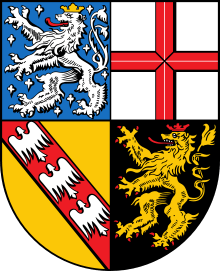Johannes Hoffmann (CVP)

Johannes Hoffmann(1890–1967) was a politician. He was a founding member of the Christian people's Party and was its Chairman. He was also Minister-President of the French Saar Protectorate from 1947 to 1955.
Life
Johannes Hoffmann was born in 1890 in Landsweiler speeches. He came from a humble background. After graduation, he studied theology in Trier only with the aim to become a priest. Soon, however, he changed his mind, moved to the Albert-Ludwigs-Universität Freiburg and studied journalism. After the start of World War I he volunteered, fought among others in Turkey and was awarded the Iron Crescent.
After the First World War Johannes Hoffmann worked as a journalist at the central organ of the German Center Party in Berlin. On 1 October 1929 he was chief editor of the newspaper Saarbrücker country, the largest Catholic newspaper in the Saar. He was referring to the rise of Hitler in the Saar press that was still available at this time, standing against the Nazis. In 1934 he was therefore dismissed in an action anticipatory obedience as editor in chief. He then founded the New Saar Post and struggled in his articles against the National Socialist regime and against the connection of the Saarland into the German Reich. After the Saar plebiscite on January 13, 1935, he emigrated first to France, then to Luxembourg. In 1936 the German citizenship was revoked. Fearing German reprisals him the Luxembourg Government refused admission as a journalist, so he could publish a few articles in the Luxemburger Wort. To feed his family, he leased a farm. He was active in the Popular Front movement Lutetia Circle. In 1939 he was employed at the German program of French radio in Paris. In his broadcasts, he reported on crimes committed by the Nazi regime. In 1940, he was interned at the beginning of the campaign in the west of the French in Audierne, in the Finistère (Brittany). After the fall of France Hoffmann fled to the unoccupied zone. By 1941, he was hiding in a monastery in Provence. In 1941, using a fake passport, he managed to leave through Spain to Portugal. He traveled to Brazil. In Rio de Janeiro, he was accepted by the Canadian Ambassador to the house. He was co-founder and head of the Free German movement in Brazil.
Postwar career
Hoffmann returned in the Saarland in 1945, was a founding member of the Christian people's Party and was its Chairman. The election took place almost unanimously on the basis of his personal integrity. At the same time, he became editor of the Saarland Volkszeitung (organ of the CVP) and co-editor of new Saarbrücker Zeitung. In 1947, he was President of the Constitutional Commission and the Legislative Assembly of the Saarland, which adopted the Constitution of Saarland. From 1947 to 1955, he was Prime Minister of Saarland. In 1950, he reached an end of the French occupation regime for Saarland. Due to its policy, the Saarland in 1953 was in fact an independent State. His goal was, "for the Saar contributes a solution finding to the relaxation of the German French relationship and promotes the necessary European unity" (Hoffmann). He pursued a separatist policy in aiming to separate the Saarland of Germany not only economically, but also politically. After the 1955, at which, the majority of the population rejected the Saar Statute negotiated between Germany and France and therefore the Europeanisation of the Saar, Saar, he stepped down as Prime Minister. A solution of home Parties directed against him before the vote was called: "The thickness must go." Hoffmann and the CVP policy was characterized by a close economic and political tie to France, while an active social policy and authoritarian domestic politics. In 1956 he retired permanently from politics. He published in 1963 still aimed at Europe, in which he outlined his policy goals and gave an account of his reign. Hoffmann died in Völklingen in 1967 and was buried in the cemetery of new world in Saarlouis - his grave is located right next to his opponent and future successor Hubert Ney.
